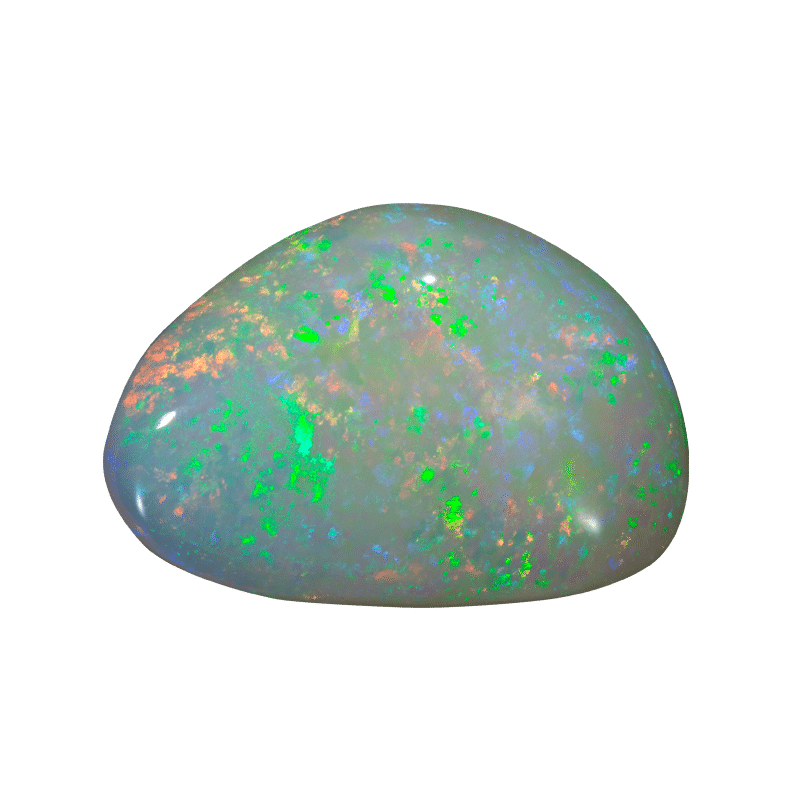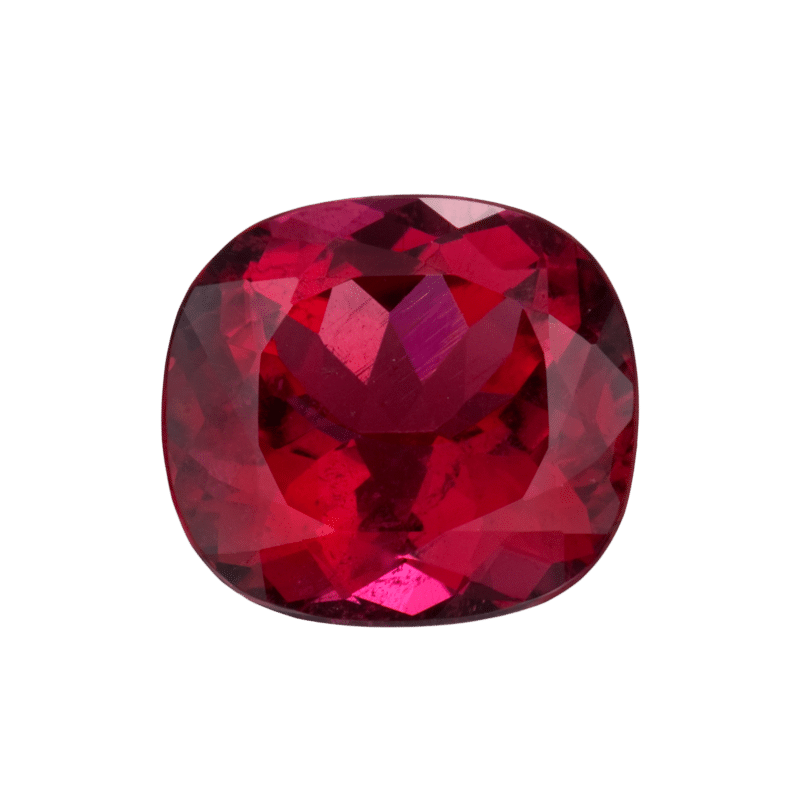October’s sign is Libra, represented by the scales. Libras are said to value balance, harmony, diplomacy — and options. Fittingly, then, the month of October has two beautiful birthstones: opal and tourmaline. Both have a mix of bold colors and interesting qualities. Let’s dive in to learn about the history of these gorgeous, colorful October birthstones.
October Birthstones #1: Opals
 Opals are brilliant, multi-hued gems. Precious opals (a classification that applies to 5% of all opals) glint when held up to the light, reflecting tiny points of sparkling jewel colors. This phenomenon, known as iridescence, means that you can easily spend hours looking at an opal in different lights, appreciating it from any number of angles.
Opals are brilliant, multi-hued gems. Precious opals (a classification that applies to 5% of all opals) glint when held up to the light, reflecting tiny points of sparkling jewel colors. This phenomenon, known as iridescence, means that you can easily spend hours looking at an opal in different lights, appreciating it from any number of angles.
According to Geoscience Australia, “opals consist of small spheres of silica arranged in a regular pattern, with water between the spheres.” It is these spheres that reflect light, creating the iridescence or indeed “opalescence.” Larger or smaller spheres create different ranges of colors. Their name might come from the Greek, opallos, meaning ‘to see a change (of color),’ or from the Sanskrit for ‘(precious) stone,’ reflecting that the ancients were as mesmerized by opals as we are today.
Opals come in different-colored varieties, ranging from black (the rarest and most precious opal type), to gray, green, and white. They can even be colorless.
The Geography of Opals
Opal is not just the October birthstone, it’s Australia’s national gemstone, too. This is because Australia produces roughly 95% of the world’s opal supply. Opal mining is in turn largely concentrated in the state of South Australia. The town of Cooper Pedy is legendary for its production of large and magnificent opals; it’s residents live in distinctive underground homes to avoid the extreme heat. In spite of the inhospitable living conditions, Cooper Pedy has lured thousands from all over Australia and, after WWII, Europe, with the promise of miners striking it rich discovering opals. Lightning Ridge is another burg well-known for its glorious black opals. Opals in Australia once were often found by miners working solo with picks, but technology has made it a much more sophisticated, if still dangerous, industry.
Mexico, Brazil, Ethiopia, and the American state of Nevada are responsible for the remaining global supply of opals. Opals usually occur in thin veins woven through rock, which can then be isolated. Fortunate miners have discovered giant opals in the form of dinosaur bones or prehistoric plants and even bivalves which have become fossilized.
Opal Varieties
Opals come in many varieties, with names as colorful as their iridescent contents. Some of these include:
- Jelly Opal, a transparent precious opal with a gelatinous appearance and a bluish sheen;
- Claro Opal, a transparent opal from Mexico with ‘an intense red, green, blue and yellow play of color’;
- Mexican Fire Opal, a Mexican opal with dominant red and orange flamelike textures;
- Lemon Opal, an opal with a dominant pale yellow color.
Other evocatively named varieties include Milk Opal, Moss Opal, and Pinfire Opal, so-called for its brilliant, bright points of light.
Opals and Value
The world’s most valuable black opal, the Aurora Australis, was found in 1938 in Lightning Ridge and was named for the bright southern stars in the night sky, whose sparkles it evokes. It was valued at AUD 1,000,000 in 2005.
Opals and Symbolism
To the Ancient Romans, the opal symbolized love and hope, and the Roman scholar Pliny marveled at the kaleidoscopic richness of opals, which could “simulate the flaming fire of burning sulphur and even the bright blaze of burning oil.” With its ability to seemingly contain lightning inside, it has hints of good luck, royalty, and magic.
Opals in Fashion
An 1829 novel by Sir Walter Scott called “Anne of Geierstein” popularized a superstition about wearing opals as a sign of bad luck. But this superstition, with its roots in actual fiction, has been forgotten. Nowadays opals are beloved by fashion designers for their versatility, their striking appearance, and the allure of their individuality, as no two opals are alike.
High-end designers have included opals in their recent collections. Victoire de Castellane, creative director of Dior Jouaillerie, describes the opal as a “very poetic stone”…
“it’s like an invitation to enter a fairy tale, to experience magic. When I look at an opal, I feel like I’m seeing the earth from afar, the ocean, the archipelagos, and the reflections of stars on ocean waves… I see it as nature’s gemstone par excellence, a stone that’s so intertwined with femininity, its connection becomes organic.”
Lucky news for those born in October, then, who get to have the opal as their birthstone. Opals can be seen these days in beautiful earrings, necklaces, and ring settings alike. Style icon Taylor Swift wore opal earrings to the 2020 Golden Globe awards, proving that opal jewelry is making a comeback.
As well as being October’s birthstone, they are an increasingly popular choice for engagement rings.
October Birthstone #2: Tourmaline
 October babies have double the luck as they get to have tourmaline as their second birthstone. Tourmaline, comprised of a large group of boron silicate materials, comes in a variety of colors — common varieties include green, blue, pink, and yellow. The different colors are a result of different traces of minerals. The presence of iron and titanium create green and blue, while manganese leads to reds, pinks, and (possibly) yellows.
October babies have double the luck as they get to have tourmaline as their second birthstone. Tourmaline, comprised of a large group of boron silicate materials, comes in a variety of colors — common varieties include green, blue, pink, and yellow. The different colors are a result of different traces of minerals. The presence of iron and titanium create green and blue, while manganese leads to reds, pinks, and (possibly) yellows.
If tourmaline’s colors vary, what makes it a distinctive gem? The answer lies in the distinctive shape of tourmaline’s crystal structure, described as triangular and prismatic. Tourmaline, first recorded in 1554 by Francisco Spinoza as “Brazilian emerald,” also exhibits pleochroism. That is, it exhibits different colors when seen from different angles, under different lights. Some tourmaline samples are faceted. They exhibit multiple colors, like layers in Neopolitan ice cream, because they were cut from color-zoned crystals. Pink and green bicolor stones are known as “watermelon tourmaline.”
Tourmaline is found in large deposits in Brazil and the US (including the states of California and Maine), Madagascar, and Ethiopia. Its name comes from a Singhalese word, “touramalli,” meaning “mixed colored stones”. Interestingly, tourmaline when heated yields a positive charge at one end of the crystal and a negative charge at the other, thereby attracting lightweight substances. This phenomenon is known as plezoelectricity and has scientific applications in the world of making pressure gauges (to name one example). This makes tourmaline an extremely useful gem in addition to its attractiveness.
Mystical Associations of Tourmaline
In feng shui, tourmaline is said to balance yin and yang energies, putting the masculine and feminine into equilibrium. It is also said to be helpful in protecting energy and putting up a barrier against others’ negative energies.
Tourmaline, in general, is believed to be very helpful for balancing and energizing the chakras. (The chakras are a system of energy points in the body in Sanskrit.) It is believed they should stay open and full of light. Over time, the chakras can become blocked, their energy stagnant. Different color tourmalines are associated with each particular chakra. For example, pink tourmaline is said to promote joy and love, green is said to open the heart chakra, and blue activates the third eye and the throat chakra. The aforementioned watermelon tourmaline is connected to the heart chakra, and bring passion and love to the wearer. Wearing tourmaline can help the wearer revamp their internal energy.
Tourmaline in Fashion and History
The Chinese Dowager Empress Tz’u Hsi was a particular fan of red and pink tourmaline from San Diego County, California. So much so that China became an enormous market for tourmaline, whose artisans crafted it into delicate jewelry, snuff boxes, and other pieces that adorned the Empress’s Court. Between 1902 and 1910, San Diego provided China with 120 tons of pink tourmaline. Such was the symbiosis between the two countries that when the Chinese government collapsed in 1912, it took the US tourmaline trade with it. Nonetheless, many beautiful tourmaline artifacts exist from the period, testaments to the beauty of the raw material of tourmaline and the skill and craft of Chinese artisans.
Native Americans have historically used pink and green tourmaline as funeral gifts.
Many wearers simply appreciate tourmaline for its aesthetic beauty. It is a popular stone in pendant, necklace, and ring form. Jewelers love playing with tourmaline’s variety both on its own and when it is paired with other gems, like diamonds, for striking contrasts.
Tourmaline’s structure and multi-colored facts can also lend themselves to intricate cutting patterns like concave faceting — a treatment that can give a dazzling, flower-like effect to gems.
Different regions tend to produce differently-colored tourmaline. Brazil produces strikingly blue tourmaline, while the California tourmaline so prized by the Dowager Empress was a mix of pink and green. Maine tourmaline tends to be pink, while copper deposits in Africa tend to produce rich green tourmaline.
If you want to express your own connection to these two beautiful and unique October birthstones, contact Brinker’s Jewelers today to see the selection of jewelry we carry in these colorful gemstones.


















